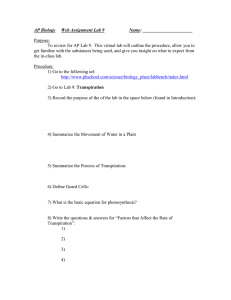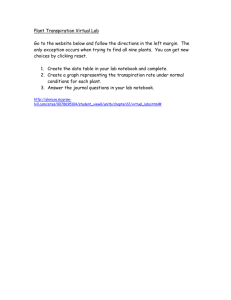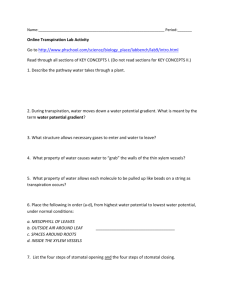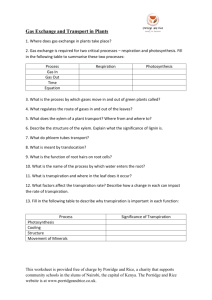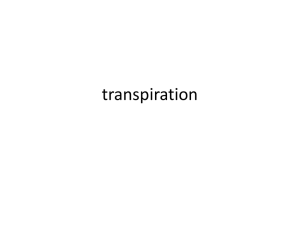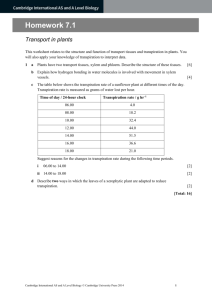INFLUENCE OF INTENSIVE MANAGEMENT ON CANOPY TRANSPIRATION IN LOBLOLLY PINE
advertisement
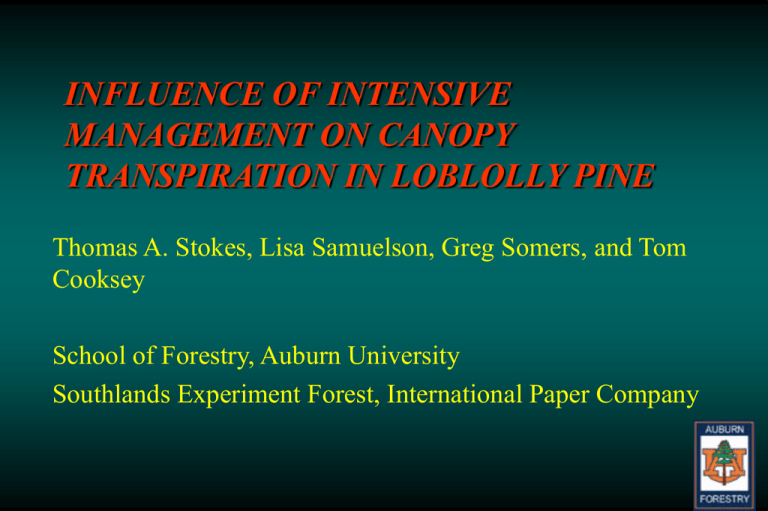
INFLUENCE OF INTENSIVE MANAGEMENT ON CANOPY TRANSPIRATION IN LOBLOLLY PINE Thomas A. Stokes, Lisa Samuelson, Greg Somers, and Tom Cooksey School of Forestry, Auburn University Southlands Experiment Forest, International Paper Company Growth 14 Control Irrigation Fertigation 12 10 8 DBH (cm) Height (m) 6 4 2 0 1998 LAI Objectives • Quantify stand and tree water use • Determine how resource availability mediates canopy physiological response to environmental stress • Examine the influence of resource availability on critical transpiration (Ecrit) – Ecrit is the rate at which transpiration begins to level off or even decline to reduce water loss (adapted from Kolb and Sperry 1999) Hypothesis • Critical transpiration will increase with nutrient and water availability. • Loblolly pine operates close to critical transpiration rate. Study Site • • • • • 15-ha plantation in Bainbridge, GA 44 x 44m plot size 2.5 x 3.7m spacing / 1080 trees ha-1 drip irrigation system randomized complete block design Treatments Control: complete weed control Irrigation: drip irrigation 1998: January through October, of 51,000-75,000 l plot-1 month-1. Fertigation: fertilizer solution 1998: 112 kg N ha-1 yr-1, 28 kg P ha-1 yr-1, and 90 kg K ha-1 yr-1. Methods: Canopy Level Measurements • Sap flow measurements recorded hourly along with VPD, PAR, and air temperature from June 1999 to May 2000. • 30 mm thermal dissipation probes were installed the north and south aspect of each tree used for leaf level measurements. • Dendrometer bands were placed on each tree to obtain current sapwood area measurements for each month. Methods: Leaf Level Measurements • Leaf gas exchange and XPP measured at 0900, 1100, 1300 and 1500 with predawn XPP June through September 1999. • Leaf gas exchange measurements were made with a Li6400 on four fascicals per tree, two tree per treatment plot and replicated on two blocks per measurement time. • XPP was measured with a PMS pressure chamber on one fascical per measurement time on the same trees as gas exchange measurements. Sap Flow 6 Control Irrigation Fertigation Sap Flow (l h -1) 5 4 3 2 1 0 0 20 40 60 Hours 80 100 120 Water use (kg tree -1 season-1) Seasonal Water Use 8000 Control Irrigation Fertigation 7000 6000 5000 4000 3000 2000 1000 0 Jun-Aug 99 Sept-Nov 99 Dec 99-Feb 00 Mar-May 00 Month Average Daily Canopy Transpiration Rate Control Irrigation Fertigation 2.5 2 a 1.5 a a 1 ab b b 0.5 Month -9 9 D ec 9 N ov -9 O ct -9 9 9 Se p9 A ug -9 9 9 Ju l-9 9 0 Ju n9 EC (mmol m-2 s-1) 3 Predawn Xylem Pressure Potentials -0.1 XPP (MPa) -0.3 -0.5 -0.7 -0.9 Control Irrigation Fertigation -1.1 -1.3 -1.5 Jun-99 Jul-99 Aug-99 Month Sep-99 Critical Transpiration Stomatal Control of Water Loss 150 Control Irrigation Fertigation gs (mmol m-2 s-1) 130 110 90 Ecrit 70 50 0 0.25 0.5 0.75 1 1.25 EC (mmol m-2 s-1) 1.5 1.75 2 Critical Transpiration Stomatal Control of Water Loss • Obtain a quadratic function of stomatal conductance over time. – gsmax = B0 + B1T + B2T2 • Take the derivative of the function in respect to time to determine the time at which the slope = 0 which corresponds to the time of gsmax. – T = -B1/(2*B2) • To determine the transpiration rate at the time of gsmax simply enter the time into the linear equation for transpiration over time. – E @ gsmax = D0 + D1T Critical Transpiration Stomatal Control of Water Loss 150 130 gs (mmol m-2 s-1) Control Irrigation Fertigation 136.8 a 119.6 ab 110.1 b 110 90 0.70 1.09 0.85 70 P=0.3751 50 0 0.25 0.5 0.75 1 1.25 EC (mmol m-2 s-1) 1.5 1.75 2 Critical Transpiration Rate Stomatal Control of Water Loss 2 Control Irrigation Fertigation EC (mmol m-2 s-1) 1.75 1.5 1.25 1 0.75 ECrit 0.5 0.25 0 -2 -1.75 -1.5 -1.25 -1 XPP (MPa) -0.75 -0.5 -0.25 0 Critical Transpiration Rate Stomatal Control of Water Loss • Obtain a linear and quadratic function for transpiration over XPP. – E = B0 + B1XPP – E = D0 + D1XPP + D2XPP2 • Take the derivative in respect to XPP to determine when the relationship between transpiration and XPP deviates from linear. – XPP = (B1 – D1)/(2 * D2) • Solve for critical transpiration by entering the XPP value into the quadratic function. – Ecrit = D0 + D1XPP + D2XPP2 Critical Transpiration Rate Stomatal Control of Water Loss 2 Control Irrigation Fertigation EC (mmol m-2 s-1) 1.75 1.5 1.25 1 1.13 1.08 0.75 0.76 -1.61 b 0.5 -1.28 ab -1.20 a 0.25 0 -2 -1.75 -1.5 -1.25 -1 XPP (MPa) -0.75 -0.5 -0.25 0 Average Daily Canopy Transpiration Rate Control Irrigation Fertigation 2.5 2 a 1.5 a a 1 ab b b 0.5 Month -9 9 D ec 9 N ov -9 O ct -9 9 9 Se p9 A ug -9 9 9 Ju l-9 9 0 Ju n9 EC (mmol m-2 s-1) 3 Conclusions Ecrit (mmol m-2 s-1) gs vs E 1.0 (0.35) E vs XPP 0.9 (0.26) Pataki et al 1998 1.09 • Ecrit appears stable with varying resource availability and degree of canopy development. • Trees operate close to Ecrit.
